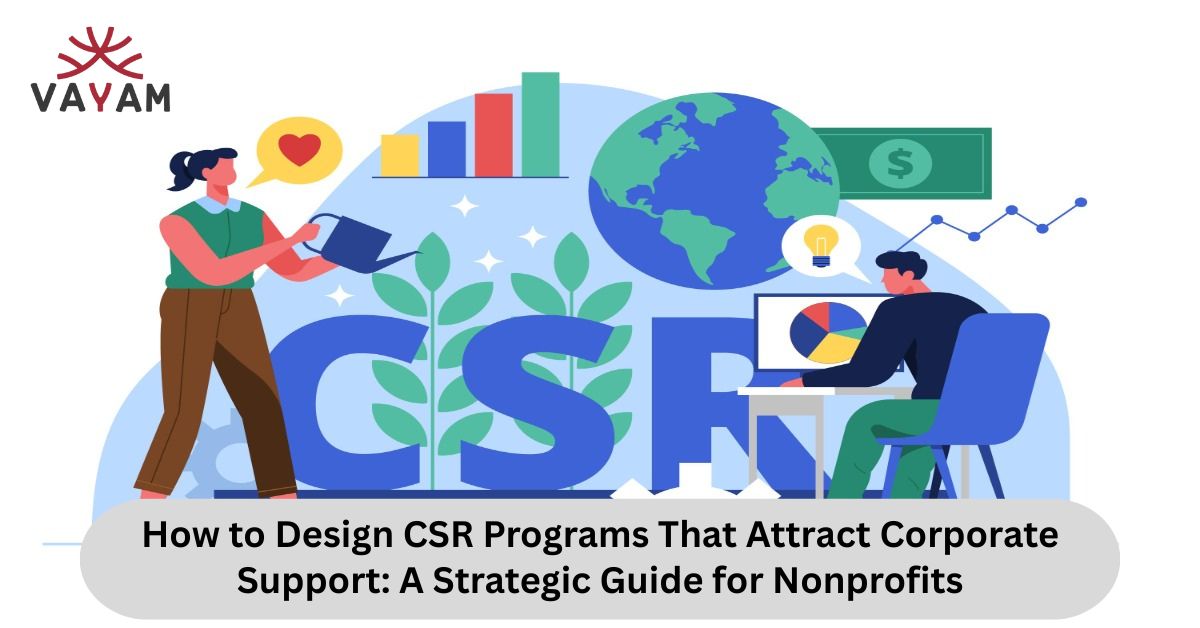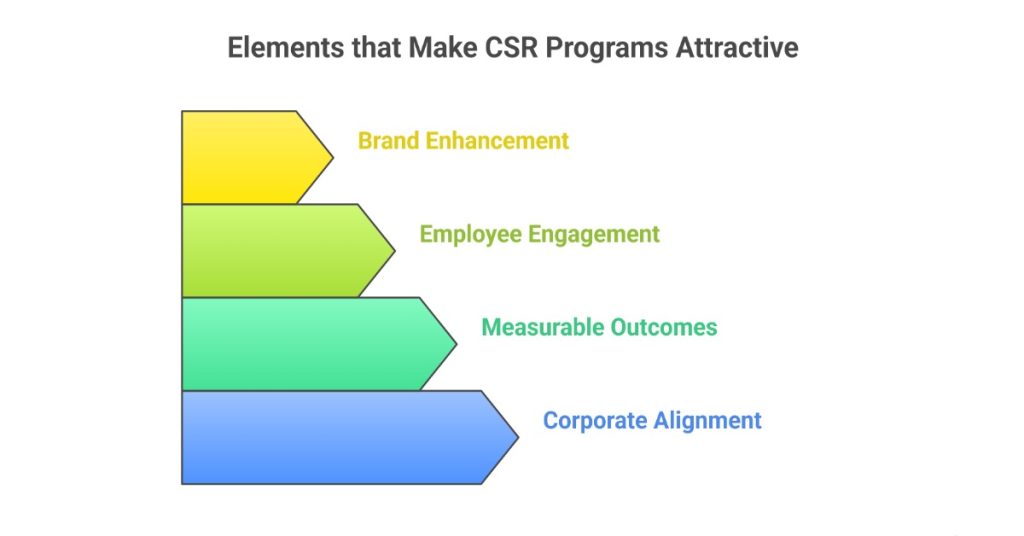
Corporate Social Responsibility (CSR) partnerships have evolved from simple check-writing exercises to sophisticated strategic alliances that drive meaningful change. For nonprofits seeking corporate support, understanding how to design compelling CSR programs isn’t just beneficial—it’s essential for survival in today’s competitive funding landscape.
The shift toward purpose-driven business has created unprecedented opportunities for organizations willing to think strategically about corporate engagement. Companies are no longer satisfied with surface-level philanthropy; they want partnerships that align with their values, enhance their reputation, and create measurable impact.
Understanding the Modern Corporate Mindset
Today’s corporations approach CSR with a business lens, seeking partnerships that deliver both social impact and tangible business value. This dual focus means nonprofits must design programs that speak to corporate objectives while advancing their mission.
The most successful CSR partnerships address specific business challenges or opportunities. Companies want to see how supporting your cause can help them attract talent, strengthen customer loyalty, enter new markets, or enhance their brand reputation.
Understanding this perspective is crucial for nonprofits. When you frame your programs in terms of mutual benefit rather than one-sided requests for support, you position yourself as a strategic partner rather than a charity case.
Key Elements That Make CSR Programs Attractive to Corporations
Alignment with Corporate Values and Mission
The foundation of any successful CSR partnership lies in authentic alignment between your nonprofit’s mission and the corporation’s values. Companies increasingly scrutinize potential partnerships to ensure they reflect genuine commitment rather than opportunistic associations.
Research potential corporate partners thoroughly before approaching them. Study their mission statements, sustainability reports, and public commitments. Look for natural connections between your work and their stated priorities.
Successful alignment goes beyond surface-level connections. If you’re an environmental organization, don’t just target companies that mention sustainability—find those whose business models could genuinely benefit from environmental improvements or who face real environmental challenges in their operations.
Clear Measurable Outcomes
Corporations live and breathe metrics, and your CSR program must deliver quantifiable results. Vague promises about “making a difference” won’t suffice in today’s data-driven business environment.
Develop specific, measurable outcomes that matter to both your mission and your corporate partner’s objectives. These might include lives improved, skills developed, environmental impact reduced, or communities strengthened.
Create measurement frameworks that track both social impact and business benefits. Corporate partners need to demonstrate ROI to their stakeholders, so help them tell a compelling story about the partnership’s value.
Employee Engagement Opportunities
Modern employees, particularly millennials and Gen Z workers, expect their employers to support meaningful causes. CSR programs that offer authentic employee engagement opportunities are particularly attractive to corporations facing talent acquisition and retention challenges.
Design programs that allow corporate employees to participate directly in your work. This might include volunteer opportunities, skills-based mentoring, or professional development programs that benefit both your beneficiaries and their staff.
Employee engagement activities should feel meaningful rather than tokenistic. Organize experiences that allow corporate volunteers to see the direct impact of their participation and develop genuine connections to your cause.
Brand Enhancement Potential
Corporations invest in CSR partnerships partly to enhance their reputation and differentiate themselves in competitive markets. Your program should offer legitimate opportunities for positive brand association without appearing overly commercial.
Consider how your partnership can help corporations tell authentic stories about their commitment to social responsibility. This might involve case studies, speaking opportunities, or award nominations that showcase the partnership’s impact.
Be mindful of avoiding partnerships that could appear as “greenwashing” or superficial marketing exercises. Authenticity is crucial for both your credibility and your corporate partner’s reputation.

Strategic Approaches to Program Design
The Problem-Solution Framework
Structure your CSR program around a clear problem-solution framework that demonstrates both need and opportunity. Start by identifying pressing social issues that align with potential corporate partners’ interests or challenges.
Present the problem with compelling data and human stories that create emotional connection. Follow this with a clear explanation of how your proposed solution addresses the issue and why corporate partnership is essential for success.
This framework helps corporations understand exactly what their investment will accomplish and how they can communicate the partnership’s value to their stakeholders.
Multi-Stakeholder Benefits
Design programs that create value for multiple stakeholder groups simultaneously. The most attractive CSR partnerships benefit the nonprofit’s constituents, the corporate partner’s business objectives, their employees, and often their customers or community.
Map out all potential beneficiaries of your proposed partnership and articulate specific value propositions for each group. This comprehensive approach demonstrates sophisticated thinking and maximizes the partnership’s appeal to corporate decision-makers.
Consider how your program might help corporations address multiple business challenges simultaneously, such as talent development, community relations, and brand differentiation.
Scalability and Sustainability Planning
Corporations prefer partnerships with growth potential and long-term viability. Design your CSR program with clear paths for expansion and evidence of organizational capacity to manage increased support.
Demonstrate how additional corporate investment can multiply impact rather than simply expanding existing activities. This might involve replicating successful programs in new locations, serving additional populations, or developing new service offerings.
Address sustainability from the outset by showing how corporate support will help build organizational capacity and potentially attract additional funding sources. Corporations don’t want to commit to indefinite support, so demonstrate how their investment will create lasting change.
Building Compelling Value Propositions
Understanding Corporate Decision-Making
Corporate CSR decisions typically involve multiple stakeholders with varying priorities. Understanding this decision-making landscape is crucial for crafting compelling proposals that address diverse concerns and interests.
Research the typical CSR approval process at target corporations. Identify key decision-makers, influencers, and evaluation criteria. This insight helps you tailor your approach to address specific concerns and priorities at each level.
Consider the different perspectives within corporations: executives focus on strategic alignment and ROI, marketing teams consider brand implications, HR departments evaluate employee engagement potential, and operational leaders assess implementation feasibility.
Quantifying Return on Investment
Develop clear frameworks for measuring and communicating return on investment that matter to corporate stakeholders. This includes both social return on investment (SROI) and business benefits that result from the partnership.
Business benefits might include improved employee satisfaction scores, positive media coverage, enhanced brand reputation metrics, or new business development opportunities. Quantify these benefits whenever possible and provide benchmarks for comparison.
Create reporting systems that track and communicate progress regularly. Corporate partners need ongoing evidence that their investment is generating expected returns and creating meaningful impact.
Risk Mitigation Strategies
Address potential partnership risks proactively to increase corporate comfort with supporting your programs. Common concerns include reputational risk, program effectiveness uncertainty, and organizational capacity questions.
Develop comprehensive risk management frameworks that identify potential challenges and mitigation strategies. This might include backup plans for program delivery, quality assurance measures, and crisis communication protocols.
Demonstrate organizational stability and professional management through transparent financial reporting, board governance information, and track record documentation. Corporations need confidence in your ability to deliver on commitments.

Implementation Best Practices
Research and Due Diligence
Thorough research forms the foundation of successful corporate partnership development. Invest significant time understanding potential partners’ business models, challenges, opportunities, and existing CSR commitments before making any approach.
Analyze corporate annual reports, sustainability documents, press releases, and leadership statements to identify authentic alignment opportunities. Look for companies facing business challenges that your expertise could help address.
Research key decision-makers and their professional backgrounds, interests, and previous nonprofit affiliations. Personal connections and shared interests often provide more effective entry points than cold outreach.
Relationship Building Strategies
Corporate partnership development is fundamentally about relationship building rather than transactional fundraising. Invest in developing genuine connections with corporate stakeholders before presenting partnership proposals.
Attend industry conferences, networking events, and community gatherings where corporate representatives participate. Engage in conversations about shared interests and community challenges rather than immediately pitching partnership opportunities.
Invite corporate representatives to visit your programs, meet beneficiaries, and observe your work firsthand. These experiences create emotional connections that complement logical business arguments for partnership.
Proposal Development and Presentation
Craft partnership proposals that speak to corporate priorities while clearly articulating how support will advance your mission. Structure proposals like business cases with executive summaries, problem statements, proposed solutions, budget information, and expected outcomes.
Include compelling storytelling that illustrates both need and impact potential. Use data to support your arguments while incorporating human stories that create emotional connection to your cause.
Present proposals professionally with high-quality materials that reflect your organization’s competence and attention to detail. Consider interactive presentations that allow corporate stakeholders to experience your work directly.
Maintaining Long-Term Corporate Partnerships
Communication and Reporting
Establish regular communication rhythms that keep corporate partners informed and engaged without overwhelming them with unnecessary updates. Develop reporting templates that efficiently communicate progress, challenges, and successes.
Provide both quantitative data and qualitative stories that help corporate partners understand the human impact of their investment. Include photos, beneficiary testimonials, and specific examples that bring your work to life.
Be proactive in addressing challenges or changes in program delivery. Corporate partners appreciate transparency and the opportunity to problem-solve together rather than learning about issues after the fact.
Recognition and Stewardship
Develop comprehensive recognition programs that acknowledge corporate partners appropriately while maintaining focus on your mission and beneficiaries. Recognition should feel authentic and proportionate to the partnership’s scope and impact.
Create opportunities for corporate partners to share their involvement with their stakeholders through speaking engagements, award applications, or media coverage. Help them communicate their social responsibility commitment effectively.
Provide exclusive access to program updates, impact data, and strategic planning discussions that make corporate partners feel like true collaborators rather than external funders.
Continuous Program Evolution
Successful long-term partnerships require ongoing program refinement based on changing corporate needs, community challenges, and impact evidence. Build flexibility into program design that allows for adaptation without losing core focus.
Regularly solicit feedback from all partnership stakeholders and use these insights to improve program effectiveness and relevance. Document lessons learned and best practices that can inform future program development.
Stay current with trends in corporate social responsibility, industry challenges, and community needs that might create new partnership opportunities or require program modifications.

People Also Ask: Common Questions About CSR Program Design
How do you measure the success of a CSR program?
Measuring CSR program success requires tracking both social impact and business outcomes using predetermined metrics and benchmarks. Effective measurement combines quantitative data (such as people served, funds raised, or environmental impact) with qualitative assessments (including stakeholder feedback, case studies, and long-term community changes).
Establish baseline measurements before program launch and track progress against specific targets throughout the partnership. Use third-party evaluation when possible to enhance credibility and provide objective assessment of program effectiveness.
What makes a CSR partnership sustainable long-term?
Sustainable CSR partnerships require mutual benefit, clear communication, and adaptive program design that evolves with changing corporate and community needs. Long-term success depends on demonstrating ongoing value to corporate partners while maintaining authentic focus on social impact.
Build relationships beyond transactional support by involving corporate partners in program development, strategic planning, and impact assessment. Create mechanisms for regular feedback and program refinement that keep partnerships relevant and valuable over time.
How much should nonprofits invest in CSR program development?
Nonprofits should allocate 10-15% of their fundraising budget to CSR program development, including research, proposal writing, relationship building, and program design activities. This investment typically generates higher returns than traditional fundraising approaches due to larger gift sizes and longer partnership duration.
Factor in the time required to build meaningful corporate relationships, which often takes 12-18 months from initial contact to signed partnership agreements. Budget for professional materials, events, and staff time needed to cultivate and maintain corporate relationships effectively.
What are the biggest mistakes nonprofits make when approaching corporations?
The most common mistakes include failing to research corporate priorities, making generic funding requests without clear value propositions, and underestimating the time required to build meaningful partnerships. Many nonprofits also neglect ongoing relationship management after securing initial support.
Avoid approaching corporations with predetermined programs that don’t align with their interests. Instead, research corporate priorities and design collaborative programs that address mutual objectives while advancing your mission.
How do you find the right corporate partners for your cause?
Identify potential corporate partners through systematic research that examines their stated values, existing CSR activities, business challenges, and stakeholder priorities. Look for authentic connections between your mission and their business objectives rather than superficial alignments.
Use corporate sustainability reports, press releases, and employee volunteer programs to understand their current social responsibility focus. Network through board members, volunteers, and professional associations to identify warm introduction opportunities with target corporations.
Read More
Apply Online for CSR Funding: Step-by-Step Guide
The Fastest Way to Secure CSR Partnerships for Your NGO
The 1 Funding Mistake NGOs Make When Seeking CSR Funding (And How to Fix It)
Conclusion: Building Strategic Partnerships That Last
Designing CSR programs that attract corporate support requires sophisticated understanding of business objectives, social needs, and partnership dynamics. The most successful nonprofits approach corporate engagement as strategic collaboration rather than traditional fundraising.
Focus on creating authentic value for all stakeholders while maintaining unwavering commitment to your mission and constituents. Corporate partners can provide more than financial support—they offer expertise, networks, and resources that can dramatically amplify your impact.
The investment in developing professional, strategic CSR programs pays dividends through larger gifts, longer partnerships, and enhanced organizational capacity. As corporations increasingly integrate social responsibility into their core business strategies, nonprofits that master collaborative program design will thrive in this evolving landscape.
